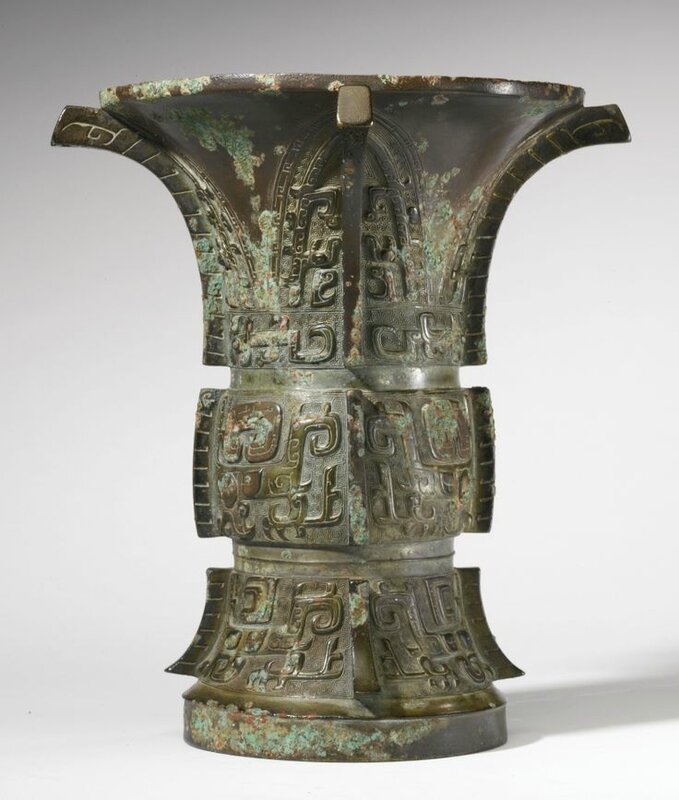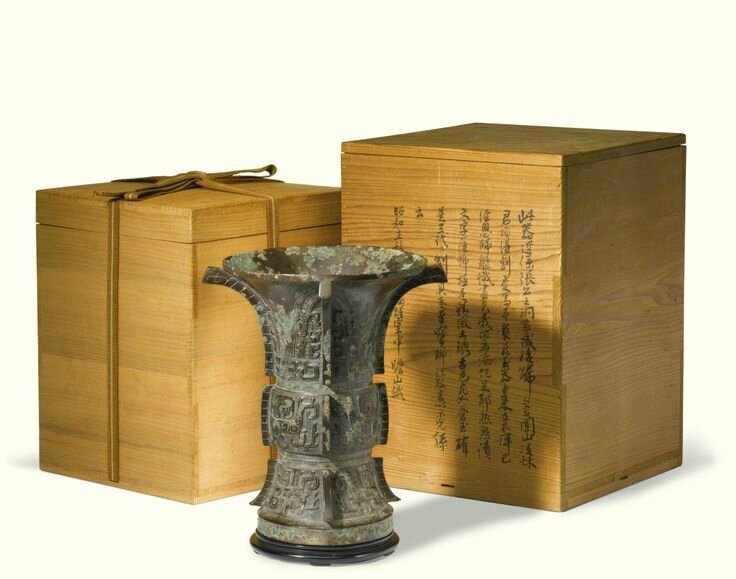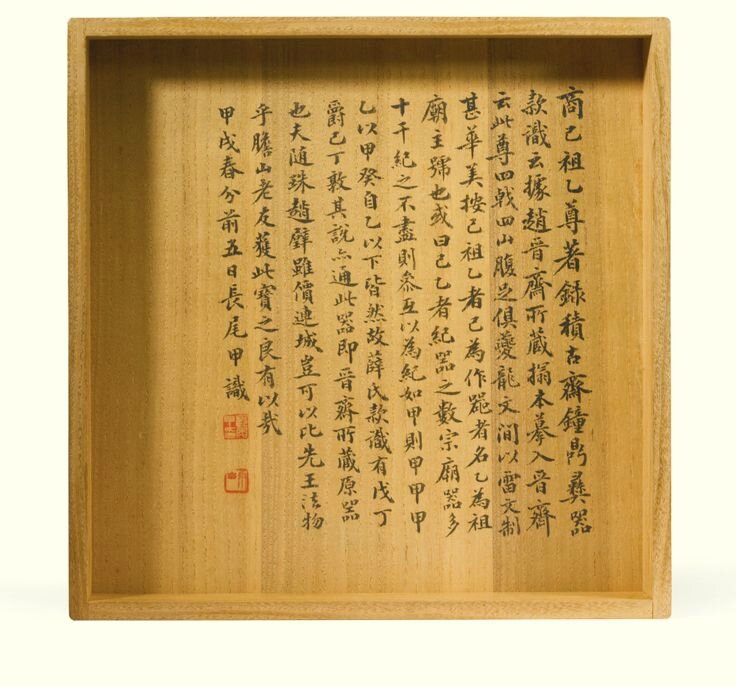The Ji Zu Yi Zun. A Magnificent And Important Bronze Ritual Wine Vessel, Late Shang Dynasty, 13th-11th Century BC.
Lot 3. The Ji Zu Yi Zun. A Magnificent And Important Bronze Ritual Wine Vessel, Late Shang Dynasty, 13th-11th Century BC. Height 12 1/8 in., 31 cm. Estimate 300,000 — 400,000 USD. Lot sold 1,265,000 USD. Photo Sotheby's
of cylindrical form with four heavy notched flanges on the sides, boldly cast around the slightly bulging waist with two taotie masks with rounded eyes, ‘C’-shaped horns, fangs and clawed arms, the splayed foot decorated with further taotie masks with rectangular slit pupils, upright horns and hooked jaws above the molded foot ring, the flaring neck with four upright blades filled with upward-looking kui dragons above a band of two pairs of confronted kui dragons, all reserved on a dense leiwen ground and detailed with intaglio, the surface with a smooth olive-green patina with light malachite encrustation, a three-character inscription on the interior of the foot, reading ji zu yi.
Provenance: Collection of Wu Dacheng (1835-1902).
Collection of Zhang Zhidong (1837-1909), by repute.
Private Japanese collection.
Litterature: Luo Zhenyu, Yinwencun, (Surviving Writings from the Yin Dynasty), 1917, vol. 1, p. 21.
Luo Zhenyu, Sandai jijin wencun, (Surviving Writings from the Xia, Shang, and Zhou Dynasties), 1936, vol. 11, p. 6.
Yan Yiping, Jinwen Zongji, (Corpus of Bronze Inscriptions), Taipei, 1983, no. 4559.
The Institute of Archaeology, Chinese Academy of Social Sciences, Yinzhou jinwen jicheng, (Compendium of Yin and Zhou Bronze Inscriptions), Beijing, 1984, vol.11, p. 46, no. 5596.
Wu Zhenfeng, Shangzhou qingtongqi mingwen ji tuxiang jicheng, (Compendium of Inscriptions and Images of Bronzes from the Shang and Zhou Dynasties), Shanghai, 2012, vol. 20, p. 329, no. 11294.
Zhou Ya, Kezhai jigutu jianzhu, (The Annotations on the Illustration of Kezhai’s [Wu Dacheng] Collected Antiquities), Shanghai, 2012, p. 90.
The provenance of this zun vessel can be traced back to the late 19th century. On the cover of the Japanese box associated with this vessel, there is an inscription written by a famous Japanese sinologist and calligrapher, Nagao Osan (1864-1942) in 1934. Mr. Nagao commented that: "the Shang dynasty Ji Zu Yi Zun was published in the Jiguzhai zhongdingyiqi kuanzhi, (Archaic Bronzes Inscriptions in the Jiguzhai Studio), which says the inscription was transcribed from an ink rubbing in the Zhaojinzhai collection." Mr. Nagao was convinced that the inscription of Ji Zu Yi in that book belonged to the present piece. However, in examining the inscription in the Jiguzhai zhongdingyiqi kuanzhi, it is clear that the writing style of that inscription varies slightly from the inscription on the present vessel. In general, the inscription on the present vessel is bolder and sharper, and the last stroke of character zu on the present vessel stretches smoothly as a continuous curve; whereas the last stroke of Zu in the publication jumped slightly at the right end. Due to the complexity of woodblock printing of images, only very few images of bronze vessels were published in ancient times. Fortunately, ink rubbings of both the vessel and the inscription of this zun vessel appear in Wu Dacheng's unpublished hand scroll, also offered in this sale. This hand scroll was commissioned by Wu Dacheng (1835-1902) to record the bronze vessels in his collection. We can now conclude that there are two Ji Zu Yi Zun, of which the present zun vessel is from the collection of Wu Dacheng. The ink rubbing of this vessel is also included in another hand scroll of Wu Dacheng's bronze collection, originally forming a set of five with the one offered in present sale, now in the Shanghai Museum and published by Zhou Ya in the Kezhai jigutu jianzhu, (The Annotations on the Illustration of Kezhai’s [Wu Dacheng] Collected Antiquities), Shanghai, 2012, p. 90.
On the outside of the Japanese box, the former Japanese collector of this zun wrote: "this vessel was from the collection of Zhang Zhidong." Zhang Zhidong (1837-1909) was one of the most influential figures in the late 19th century China and was known as a “scholar-official”. Although Zhang has not been known as a collector of archaic bronzes, he was clearly a keen student of bronze inscriptions and compiled a monograph on epigraphic materials: Zhiyatang lun jinshi zha (Essays on the Bronze and Stone Inscriptions in the Zhiyatang studio). When Wu Dacheng was appointed as the inspector-general of Hunan province, Zhang Zhidong was the governor of Hubei and Hunan provinces. According to the Wukezhai nianpu (Chronicle of Wukezhai’s [Wu Dacheng] Life), in the eighteenth year of the Guangxu era (1892), Wu Dacheng acquired a draft of a memorial to the throne written by the famous calligrapher, Liu Yong (1719-1805); Wu Dacheng showed it to Zhang Zhidong for him to write a colophon on this piece. It is evident that these two top officials in the same region also shared their interest in collecting art works. Moreover, Wu Dacheng’s fourth daughter married Zhang Zhidong’s son in the twentieth year of the Guangxu era (1894). We can therefore surmise that the present zun vessel was given to Zhang Zhidong as a gift in the 1890s. Probably after Zhang's death, the Ji Zu Yi Zun went overseas to Japan. The reunion of the Ji Zu Yi Zun and Wu Dacheng's Jijintu hand scroll after one hundred twenty years of separation is a true ‘serendipity of bronzes and stelae’.
Sotheby's. Archaic Bronzes and the Wu Dacheng Jijintu Scroll. New York. 18 mars 2014

/https%3A%2F%2Fprofilepics.canalblog.com%2Fprofilepics%2F1%2F0%2F100183.jpg)
/https%3A%2F%2Fstorage.canalblog.com%2F03%2F02%2F119589%2F96711876_o.jpg)
/https%3A%2F%2Fstorage.canalblog.com%2F11%2F31%2F119589%2F94773502_o.jpg)
/https%3A%2F%2Fstorage.canalblog.com%2F20%2F83%2F119589%2F94772815_o.jpg)
/https%3A%2F%2Fstorage.canalblog.com%2F26%2F72%2F119589%2F75604929_o.jpg)
/https%3A%2F%2Fstorage.canalblog.com%2F59%2F60%2F119589%2F26458628_o.jpg)











/image%2F1371349%2F20240406%2Fob_b23648_434058570-1644317966338216-88086167391.jpg)
/image%2F1371349%2F20240403%2Fob_6d5ae7_dp-28103-001.jpg)
/image%2F1371349%2F20240229%2Fob_8f31f9_431013694-1625286614908018-33034430839.jpg)
/http%3A%2F%2Fstorage.canalblog.com%2F79%2F20%2F119589%2F129837997_o.jpg)